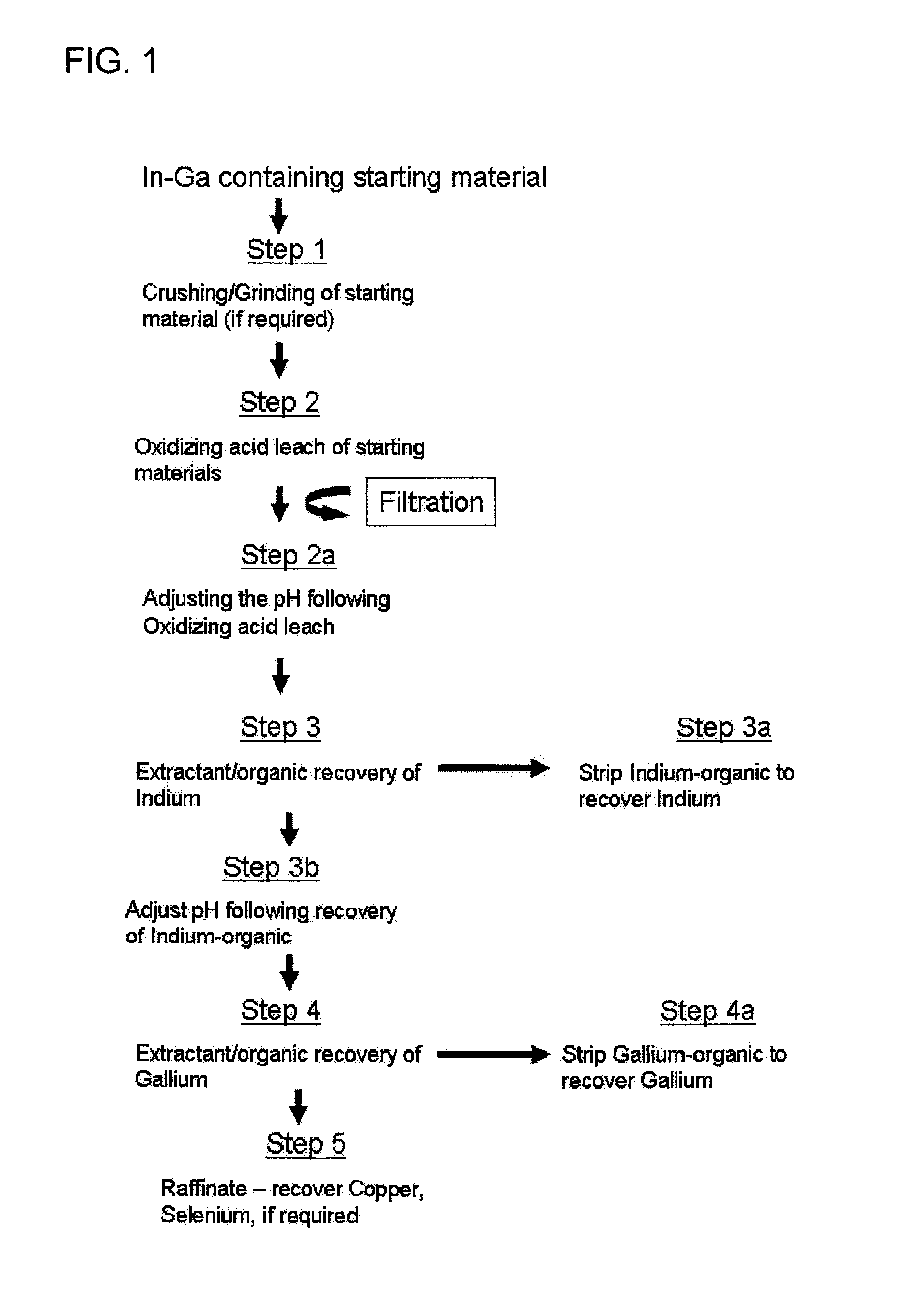Treatment of indium gallium alloys and recovery of indium and gallium
a technology of indium gallium alloys and recovery of indium gallium, which is applied in the direction of beryllium compounds, metal recycling, dissolving, etc., can solve the problems of significant risk of cross-contamination with both circuits, unsuitable for commercial scale, and complex process described
- Summary
- Abstract
- Description
- Claims
- Application Information
AI Technical Summary
Benefits of technology
Problems solved by technology
Method used
Image
Examples
example 1
[0109]Samples of various scrap material containing both indium and gallium were crushed and / or ground to a fine powder having an average particle size of less than 100 microns. Each sample was then placed in a vessel and subsequently contacted with an oxidizing acid for a certain time and at a predetermined temperature, as provided in Table 2. At the end of the time periods noted in Table 2, provided as FIG. 4, for the each test, the resulting pulp was filtered, thoroughly washed with water and residue, if any, was dried at 100° C. The filtrate washes and residues were then assayed for the elements of interest, namely indium, gallium, copper and selenium.
[0110]As noted above, Table 2 summarizes the test condition and the results obtained for each of the reaction conditions tested. The results presented in Table 2 indicated that all of the four types of indium and gallium containing scrap material tested could be used to quantitatively leach indium and gallium, and, if present, coppe...
example 2
[0111]A leaching solution generated by oxidizing acid leaching a sample of CIG, as per conditions similar to those presented in Example 1, above, was assayed after dilution with water such that the starting solution contained about: 14.9 g / L In, 2.29 g / L Ga and 3.39 g / L Cu. After adjusting the pH of the abovementioned solution to 0.56 (using caustic soda, NaOH), the leaching solution was contacted with and organic solution comprising 30% DEPHA (0.9M), 10% isodecanol as a phase modifier and 60% of an aliphatic diluent (kerosene-type, for example Escaid or Isopar 100). The volume ratio of the aqueous phase (A-aqueous leach solution) and the organic phase (O) was kept at 1(O / A=1 / 1), the pH adjusted to 0.5, and the two solutions were mixed and agitated over a time period of about 10 minutes. Following the agitation, the two resultant phases were separated by gravity separation and the aqueous phase was subjected to a second contact with the organic solution noted above under the same co...
example 3
[0112]Experiments were conducted to determined the pH at which gallium would be selectively extractable from the copper remaining in solution following the selective extraction of a major portion of the indium values. The pH of an indium solvent raffinate was adjusted to various values, using NaOH and the resulting solution, the aqueous phase, was contacted with a 30% DEPHA (0.9M) so as to produce an organic phase to aqueous phase mixture in contact for 10 minutes. The extraction of gallium was calculated by assaying the aqueous phases for each of the pH experiments. The results are presented in Table 4 of FIG. 6. With reference to Table 4, it is shown that gallium can be extracted from the substantially indium-devoid aqueous raffinate noted above once the pH is maintained at 1.5 or above, while copper is only marginally extracted, even at pH=2.0.
PUM
| Property | Measurement | Unit |
|---|---|---|
| particle size | aaaaa | aaaaa |
| length | aaaaa | aaaaa |
| length | aaaaa | aaaaa |
Abstract
Description
Claims
Application Information
 Login to View More
Login to View More - R&D
- Intellectual Property
- Life Sciences
- Materials
- Tech Scout
- Unparalleled Data Quality
- Higher Quality Content
- 60% Fewer Hallucinations
Browse by: Latest US Patents, China's latest patents, Technical Efficacy Thesaurus, Application Domain, Technology Topic, Popular Technical Reports.
© 2025 PatSnap. All rights reserved.Legal|Privacy policy|Modern Slavery Act Transparency Statement|Sitemap|About US| Contact US: help@patsnap.com



